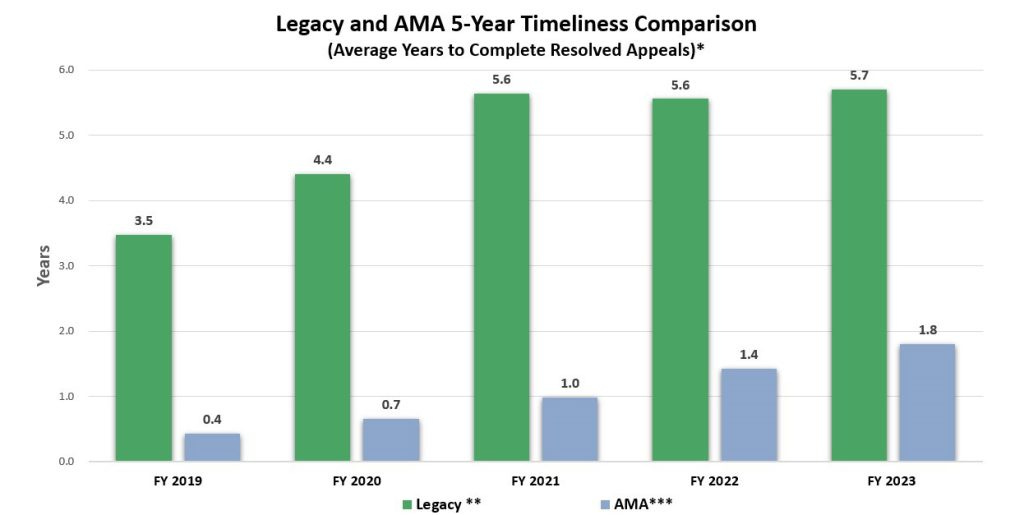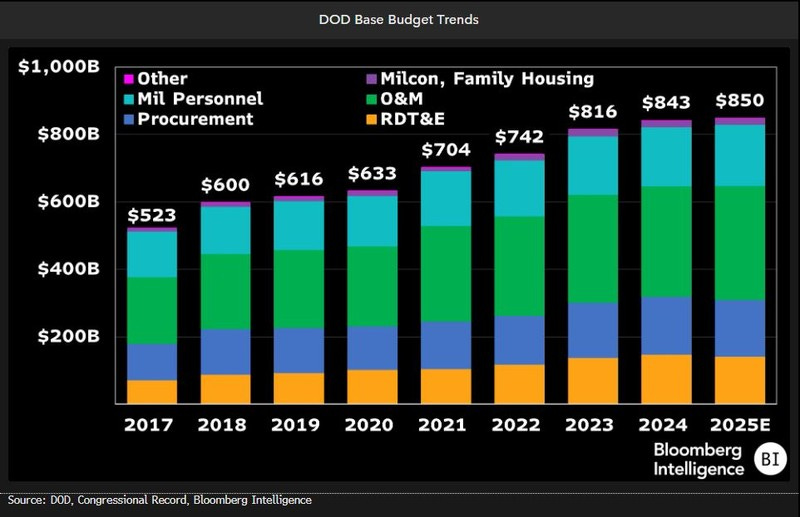The US has a runaway budget, and we cannot balance our budget without some hard decisions. Over time, expenditures on Defense, Veterans Affairs, Social Security, and Medicare have grown at an unsustainable rate. Given that Republicans hold both Congress and the White House and are unalterably opposed to tax increases, balancing the budget won’t happen in the short term. But the day is soon approaching when the interest paid on the national debt compels a reckoning. The necessary compromises will be both significant and unpopular. This week, I’ll tackle ways to address unsustainable growth in the Defense and Veterans Affairs budgets. In a future column, I’ll look at Medicare and Social Security.
Defense Reform - Faster, Cheaper, Better. In 2026, the US defense budget will likely exceed $1 trillion a year for the first time, effectively doubling since 2017. (Total inflation over the same period is only 29%.) We want a well-paid, well-equipped military, but we need to let go of the illusion that we can have those as well as 381 Navy vessels, 540,000 Army soldiers, 86 fighter squadrons, and all the other things the military claims it “must have.” These goals are built around a theory leftover from World War II - that the US should be able to fight and win two major theater wars simultaneously (or at least win one and hold in the other until forces can be shifted, which was effectively our WWII strategy). This involved maintaining a huge active-duty force, having large stocks of high-end, heavy weaponry on hand, and never relying on allies to support us.
Modern warfare has shifted to a model where a smaller number of well-trained service members use high tech weaponry rapidly produced in conjunction with allies to meet a challenge. Witness how Ukraine has leveraged a comparatively small military with Western technology to stop Russia’s ships and tanks. The Ukraine War also shows how countries can cooperate to “surge” weaponry where it is needed in the world.
Fewer People, Fewer Platforms. This reality requires a transition from a large, expensive active duty force to a smaller one with a higher level of readiness, backed up by a cheaper, but well-trained, reserve force. Similarly, rather than investing in large stores of tanks, jets, and ships, the country must invest in smaller numbers of these assets with the industrial capacity to respond quickly with whatever the conflict requires. These changes save money. A reserve service member costs about one third as much as one on active duty. Reducing the number of platforms reduces the operating costs of those platforms (although it does increase the unit production cost of each one). In sum, our focus on fighting the wars of 80 years ago has led us to an unsustainable military budget.
More Burden-Sharing with Allies. Mr. Trump has appropriately pointed out how much NATO relies on the US to shoulder the burden of collective defense. However, another important factor in that equation is that we should be able to rely on our allies to provide both personnel and military materiel to support our needs. That means shifting away from our “America Only” approach to defense procurement and co-producing military platforms with our allies. The US M1 Abrams is the best heavy tank in the world, but the Germans make more practical armored vehicles for many situations. The Ford-class aircraft carrier is the best in its class, but the Italians make a great frigate. We have taken a step in the right direction with the AUKUS submarine deal, where the US, UK, and Australia are working collaboratively to provide Australia with a modern sub fleet. Co-production allows countries to develop and share expertise across our alliances, as well as to save money by not producing “one of everything” themselves.
Veterans Affairs - Keep the Services, Cut the Bureaucracy. For decades, the VA had a reputation for slow-moving bureaucracy and poor healthcare and other services for our veterans. When I worked there, I remember reading a file where the veteran had been wrongfully denied benefits by an unsympathetic claims examiner in 1972 after service in Vietnam and had lived homeless for most of the time since. Fortunately, we were able to grant him the benefits to get the help he needed. VA healthcare and access to benefits have both improved significantly, but delays from an unnecessarily complex bureaucracy persist.
Veterans Services - Keep Pushing in the Right Direction. VA healthcare has done a good job transitioning from an entirely in-house, hospital-focused system to one that relies on more primary care. Recent improvements continue to reduce the artificial barriers between VA and private healthcare. Congress has also significantly improved VA education benefits and expanded access to healthcare to a broader spectrum of veterans. The VA budget has more than doubled since 2013.
Kill the Delays and Untether Healthcare from Disability. However, unnecessary bureaucracy continues to delay the receipt of those benefits. It takes VA about 6 months to review claims and grant or deny benefits. Appeals to the Board of Veterans Appeals average about 3 years, if the Regional Office denies benefits. The delays have gotten so bad that the business model for representing veterans now consists of charging a percentage of the back benefits granted. Access to healthcare also largely depends on filing a claim for disability compensation. Veterans go from a military position in which admission of a healthcare need is seen as a weakness to system where admission of those needs is the key to receiving benefits. This seems to be a particularly cruel form of whiplash. Disability criteria also reflect a 1970’s era view of physical labor, rather than the tasks required in the modern workplace.

Congress took a step in the right direction by allowing combat zone vets 10 years of healthcare disability from the time of their discharge, regardless of whether they make a disability claim. A commonsense approach to both healthcare and disability would be to give all veterans a period of VA healthcare equal to the length of their service after they separate; during that period they could receive a comprehensive assessment of the impact of their service on their ability to work. Currently, only veterans claiming complete disability receive such an assessment, although we know that veterans suffering from partial disabilities also have impaired earning potential. Let’s move it from an exercise in whether the veteran checks certain boxes to receive healthcare and disability payments to a system where everyone receives a period of care and an individualized assessment. The increased attention to the years immediately after separation from service would ensure that veterans get timely services.
Looking Forward, Not Back. In sum, our budgetary approach to both Defense and Veterans Affairs reflect visions of these functions from the 1970’s, if not earlier. Shifting to a more forward-looking, collaborative model doesn’t just make sense, it saves money. Similarly, we need Congress to look ahead and establish the processes that can address these problems, rather than punt them down the road. The cost of Congress’s current way of doing business is probably on the order of $500 billion a year - about a quarter of the total federal budget deficit. The current paradigm in Congress is only to engage in the process if you’re guaranteed your preferred outcome at the beginning. Truly serving the public interest means going into the process with a collaborative, positive vision of the future and a willingness to build an outcome that serves the country, working to resolve differences of opinion on how best to make it happen.
Other News
“One, Big, Beautiful Bill”. I have leaned away from getting into too much detail on this bill, largely because it changes so often and so quickly. The House has passed their version by one vote. It cuts both Medicaid and food assistance programs significantly and adds the the budget deficit by making a number of tax cuts that primarily benefit the wealthy. The Senate is poised to make some changes in the bill, which may or may not be acceptable to the House.
The general inclination among Democrats in Congress seems to be to simply do nothing and hope the disagreements between the House and Senate Republicans will doom the bill. This would be a missed opportunity, not just because it might not work, but also because voters generally support a more balanced budget. There is a deal to be made with conservative Republicans - accept some of these service cuts, but stand firm on the tax cuts in exchange for agreeing to a task force that will present a plan for balancing the budget for a vote in the November-December 2026 lame duck session. Democrats need to tackle the national debt, not run from it.
What You Can Do. I frequently receive e-mails asking what the writer can do to fight back against the injustices of the current administration. I encourage all of you to start with what you know. You probably have people in your social circle impacted by the President’s service cuts. Help them out, either individually or through the organizations that support them. Work on local campaigns to support candidates willing to do the hard work in office. Ask them if they’re willing to not just represent your values, but also to work with people they disagree with when they win. In doing this, you will likely also connect with organizations fighting the bigger fight in the courts and in national campaigns. If you’re looking for the right narrative to talk about resistance, read Nick Kristof’s recent article on the subject.
Keep Letters from a Recovering Politician Free
I’ve been writing more frequently lately in light of the onslaught of negative news. As always, the best thing you can do to support this column is to share it with people who might be interested. I do not have a paid plan because I want folks to be able to access it without worrying about money. If you’d like to leave me a tip to show your appreciation, you can click on the “Buy Me a Coffee” button below.
Disclaimer
The views expressed herein are those of the author and not necessarily those of the Department of Navy, the Department of Defense, the University of Oregon, or any other entity with which the author is affiliated.








Thank you for your thoughts and ideas.
My question, related to miilitary budgets, is the cost of the cutting edge equipment.
Just like fancy new medications, (I'm an RN) the costs keep escalating. At what point do the risks of such spending (decimating our country under debt, prioritzing weapons over food, health, and environment) exceed the benefits?
To tell you the truth, I'm ready to take on more risk. I'm tired of living in a fear-based world..... As I look at Gaza, and all our "help" there- under both administrations.. my stomach turns...destroying innocent lives, building enemies...
I grew up in Japan ( a former "enemy" not far from Hiroshima. I lived near a military hospital (in Japan) durirng Vietnam, hearing helicopters carrying wounded young men... for what?!?
I found this piece about equipment costs from 2023... and I'm sure costs are going up... what a great industry to be in if all you care about is money....How many of these weapons are blown up or get blown up, necessitating making more of them?
https://stacker.com/stories/military/most-expensive-us-military-weapons-and-programs
Sensible. You have much in common with Voltaire, “Common sense is not so common.” Keep up the good work. You are appreciated.